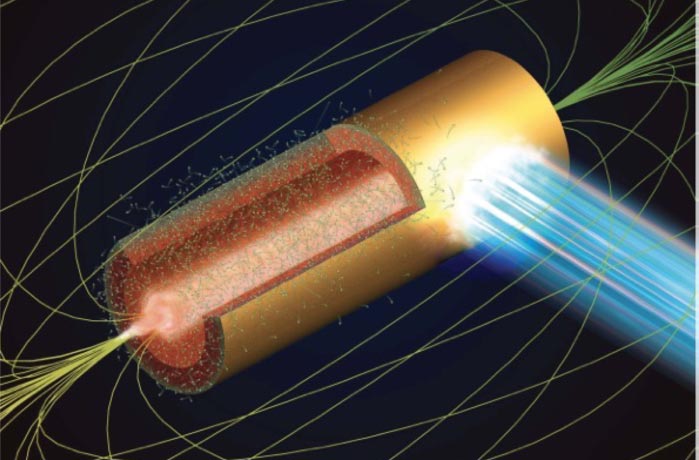Towards the achievement of megatesla magnetic fields in the laboratory

Illustration of a microtube implosion. Due to the laser-produced hot electrons with megaelectron volt energies, cold ions in the inner wall surface implode toward the central axis. By pre-seeding uniform magnetic fields of the kilotesla order, the Lorentz force induces a Larmor gyromotion of the imploding ions and electrons. Due to the resultant collective motion of relativistic charged particles around the central axis, strong spin currents of approximately peta-ampere/cm^2 are produced with a few tens of nm size, generating megatesla-order magnetic fields.
Credit: Masakatsu Murakami
High-precision 3D supercomputer simulations reveal the 3D structure of theoretically predicted micron-scale megatesla magnetic fields, optimizing engineering design of laser conditions and micron-size target structures for future laser experiments.
Recently, a research team at Osaka University has successfully demonstrated the generation of megatesla (MT)-order magnetic fields via three-dimensional particle simulations on laser-matter interaction. The strength of MT magnetic fields is 1-10 billion times stronger than geomagnetism (0.3-0.5 G), and these fields are expected to be observed only in the close vicinity of celestial bodies such as neutron stars or black holes. This result should facilitate an ambitious experiment to achieve MT-order magnetic fields in the laboratory, which is now in progress.
Since the 19th century, scientists have strived to achieve the highest magnetic fields in the laboratory. To date, the highest magnetic field observed in the laboratory is in the kilotesla (kT)-order. In 2020, Masakatsu Murakami at Osaka University proposed a novel scheme called microtube implosions (MTI) [1, 2] to generate ultrahigh magnetic fields on the MT-order. Irradiating a micron-sized hollow cylinder with ultraintense and ultrashort laser pulses generates hot electrons with velocities close to the speed of light. Those hot electrons launch a cylindrically symmetric implosion of the inner wall ions towards the central axis. An applied pre-seeded magnetic field of the kilotesla-order, parallel to the central axis, bends the trajectories of ions and electrons in opposite directions because of the Lorentz force. Near the target axis, those bent trajectories of ions and electrons collectively form a strong spin current that generates MT-order magnetic fields.
In this study, one of the team members, Didar Shokov, has extensively conducted three-dimensional simulations using the supercomputer “OCTOPUS” at Osaka University’s Cybermedia Center. As a result, a distinct scaling law has been found relating the performance of the generation of the magnetic fields by MTI and such external parameters as applied laser intensity, laser energy, and target size.
“Our simulation showed that ultrahigh megatesla magnetic fields, which were thought to be impossible to realize on earth, can be achieved using today’s laser technology. The scaling law and detailed temporal behavior of the magnetic fields in the target are expected to facilitate laboratory experiments using the Peta-watt laser system ‘LFEX’ at Osaka University’s Institute of Laser Engineering, which are now in progress,” Murakami says.
The article, “Laser scaling for generation of megatesla magnetic fields by microtube implosions” was published in High Power Laser Science and Engineering at DOI: https://doi.org/10.1017/hpl.2021.46
Reference:
[1] “Generation of megatesla magnetic fields by intense-laser−driven microtube implosions”
Scientific Reports 10, (2020) 16653. https://doi.org/10.1038/s41598-020-73581-4
[2] YouTube Murakami’s lab: https://www.youtube.com/watch?v=eL4w1uGRk4U
About Osaka University
Osaka University was founded in 1931 as one of the seven imperial universities of Japan and is now one of Japan’s leading comprehensive universities with a broad disciplinary spectrum. This strength is coupled with a singular drive for innovation that extends throughout the scientific process, from fundamental research to the creation of applied technology with positive economic impacts. Its commitment to innovation has been recognized in Japan and around the world, being named Japan’s most innovative university in 2015 (Reuters 2015 Top 100) and one of the most innovative institutions in the world in 2017 (Innovative Universities and the Nature Index Innovation 2017). Now, Osaka University is leveraging its role as a Designated National University Corporation selected by the Ministry of Education, Culture, Sports, Science and Technology to contribute to innovation for human welfare, sustainable development of society, and social transformation.
Website: https://resou.osaka-u.ac.jp/en
Journal: High Power Laser Science and Engineering
DOI: 10.1017/hpl.2021.46
Article Title: Laser scaling for generation of megatesla magnetic fields by microtube implosions
Media Contact
Saori Obayashi
Osaka University
saori_obayashi.cgin@osaka-u.ac.jp
Office: 81-661-055-886
Original Source
All latest news from the category: Information Technology
Here you can find a summary of innovations in the fields of information and data processing and up-to-date developments on IT equipment and hardware.
This area covers topics such as IT services, IT architectures, IT management and telecommunications.
Newest articles

Compact LCOS Microdisplay with Fast CMOS Backplane
…for High-Speed Light Modulation. Researchers from the Fraunhofer Institute for Photonic Microsystems IPMS, in collaboration with HOLOEYE Photonics AG, have developed a compact LCOS microdisplay with high refresh rates that…

New perspectives for material detection
CRC MARIE enters third funding period: A major success for terahertz research: Scientists at the University of Duisburg-Essen and the Ruhr University Bochum have been researching mobile material detection since…

CD Laboratory at TU Graz Researches New Semiconductor Materials
Using energy- and resource-saving methods, a research team at the Institute of Inorganic Chemistry at TU Graz aims to produce high-quality doped silicon layers for the electronics and solar industries….



